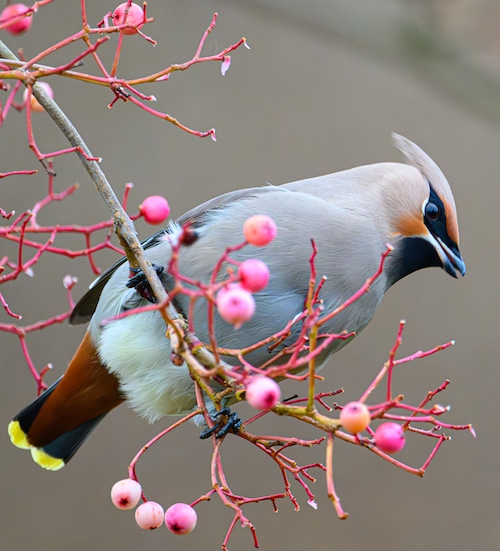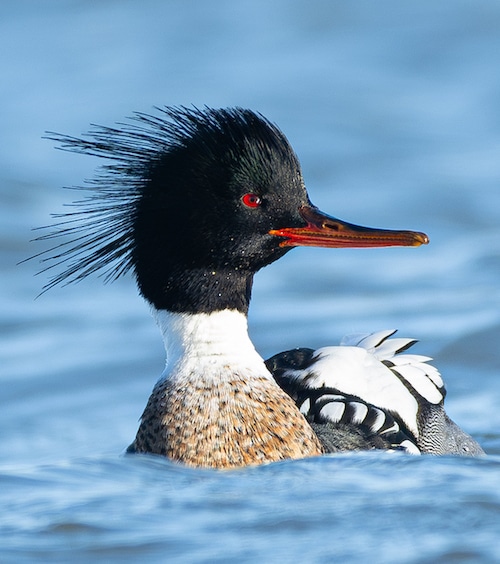North-east Scotland

The North-east Scotland Recording Area covers the unitary authorities of Aberdeenshire and Aberdeen City including (the former districts of Banff and Buchan, Gordon, Aberdeen City and Kincardine and Deeside of the old Grampian Region)
Birding North-east Scotland
Aberdeenshire and the city of Aberdeen makes up the north-east corner of Scotland, a large area including a very wide range of habitats. The habitat diversity, and the presence of many of Scotland’s speciality birds makes the region a magnet for birders visiting the UK. Here is a short list of the main habitats, and the key birds to find there:
Urban areas – Aberdeen is Scotland’s third most populous city, one of Scotland’s 32 local government council areas and the United Kingdom’s 37th most populous built-up area, with an official population estimate of 196,670 for the city of Aberdeen itself and 228,990 for the local authority area. Nicknames include the Granite City, the Grey City and the Silver City with the Golden Sands. During the mid-18th to mid-20th centuries, Aberdeen’s buildings incorporated locally quarried grey granite, which can sparkle like silver because of its high mica content. Being sited between two river mouths, the city has little natural exposure of bedrock. On the coast, Aberdeen has a long sand beach (good for Red-throated Divers, Red-breasted Merganser, Purple Sandpiper & Sanderling) between the two rivers, the Dee and the Don, which turns into high sand dunes north of the Don stretching as far as Fraserburgh; to the south of the Dee are steep rocky cliff faces with only minor pebble and shingle beaches in deep inlets. A number of granite outcrops along the south coast have been quarried in the past, making for spectacular scenery.

Red-breasted Merganser Mergus serrator – Ythan Estuary ©Ron Macdonald
Aberdeen has long been famous for its 45 parks and gardens, and citywide floral displays which include two million roses, eleven million daffodils and three million crocuses. Duthie Park on the north bank of the River Dee has extensive gardens, a rose hill, boating pond, bandstand, and play area as well as Europe’s second largest enclosed gardens. Moreover, it is a regular spot for Waxwings in winters as are Kingcorth and Old Aberdeen. Hazlehead Park, is large and forested, located on the outskirts of the city, it is popular with walkers in the forests, sports enthusiasts, naturalists and picnickers. Girdle Ness is a key migration hotspot, but also offers good sea-watching opportunities.
Seabird Cliffs – granite and basalt, among the most spectacular anywhere, with Gannets, Puffins, Razorbills, Guillemots, Kittiwakes, Shags, Fulmars, etc. in their thousands. Black Guillemot turn up in small numbers particularly on the north coast. The area offshore from Portsoy is known for its population of moulting White-billed Divers in spring, where double-figure counts have been recorded from boat trips. Birds can be scanned distantly from the coast at Portsoy and nearby Findlater Castle. Late March to mid May is the key time for White-billed Divers.
Cairngorm Mountains and foothills (overlapping into Highland Region) & Native forests – Scottish Ptarmigan (endemic sub-sp.); Scottish Crossbill (endemic sp.); Capercaillie, Black Grouse, Red Grouse, Golden Eagle, Dotterel, Ring Ouzel, etc. Please note that Capercaillie are in such low numbers encounters are very rare and reducing disturbance is key so responsible birders will not search for them. So much so that disturbing them during breeding season (March to August) would lead to prosecution! Refer to the website of ‘Lek it Be‘.
Coastal Passage areas – especially in the hot bed between Aberdeen and Fraserburgh, with good spots at Girdleness, Balmedie, Newburgh, Cruden Bay and Rattray, these are essential places to visit whenever there is a south-easterly wind, April to June and again September to November. All of the regular passage birds can be seen, as well as good numbers of real rarities, and flooded pools in the Newburgh area are excellent for rare shorebirds. The North-east Scotland recording area holds the record for the most species of birds seen in 24 hours (in Scotland) and is second only to Norfolk for the UK.
Farmland – not generally thought of as particularly good birding habitats! But the north-east still has good numbers of Corn Bunting, Grey Partridge, Lapwing, and several other breeding waders, in marked contrast to much of the rest of the country. In winter the areas around Fraserburgh and around Newburgh play host to some 30,000 Pink-footed Geese, while further inland similar numbers of Greylags spend the winter. There are also usually good numbers of Barnacle Geese, Wigeon, Teal, and Whooper Swans.
-
Banchory, Aboyne and Ballater
Satellite Viewsituated west of Aberdeen, along the river Dee. Top tourist spots (near to Balmoral Castle) hence can be a little pricey, but great bases to explore the Deeside Hills and the southern Cairngorms. Banchory is closest to Aberdeen, and handy for the Stonehaven seabird cliffs. -
Braemar
Satellite ViewBraemar - the furthest west village of the region, and well into the southern Cairngorms. Ideal for a walking holiday, or seeing the mountaintop specialities like Dotterel, Snow Bunting, Ptarmigan, Eagles, etc. but rather a long way from the coast. The scenery is beautiful and the hotels are moderately priced. If you only want the mountain birds, this is the place to be. -
Newburgh
Satellite View12 miles north of Aberdeen. A quiet village with loads of birds very close by (Forvie Sands NNR). One small, comfortable, country hotel and several B&Bs. My own personal preference, as it means birding before breakfast is possible, even after the night before! -
Strathbeg and St. Combs
InformationSatellite ViewSt. Combs is a small village not far from Strathbeg RSPB reserve, and Rattray Head coastal migrant spot, in the north-east tip of the county. Strathbeg is a superb reserve which turns up many rarities regularly. St. Combs has a very comfortable newly built hotel (the Tufted Duck) with good food and beer.
-
Ian Broadbent
-
Number of bird species: 394
-
Birding Guide to North-East Scotland
| (Including Part of the Cairngorms National Park) | by Mark Sullivan &, Ian Francis | Aberdeen and District RSPB Group | 2015 | Paperback | 130 pages, colour photos, colour maps | Out of Print | ISBN: 9780956112675 Buy this book from NHBS.com -
Where to Watch Birds in Scotland
| By Mike Madders & Julia Welstead | Christopher Helm | Paperback | 297 pages, b/w illustrations, maps | Out of Print | ISBN: 9780713656930 Buy this book from NHBS.com

Where to Watch Birds in Scotland
Apple iOS | AndroidThis app will help beginners and experts alike to discover hundreds of the best places to see and enjoy birds around the country. Where to Watch Birds in Scotland, the Scottish Ornithologists' Club's free mobile app for Apple and Android devices, now has over 580 sites. New sites will continue to be added and existing ones updated as far as possible. The app launched in April 2019 and since then has been downloaded by more than 15,000 users and amassed over 750,000 site views. It won 'Product of the Year' in Birdwatch and BirdGuides' 2019 Birders' Choice Awards, and the BTO/Marsh Award for Local Ornithology 2020.Useful Information-
Latest North-East Scotland Bird Report
Latest Report -
North-East Scotland Bird Reports
Past ReportsOnline Scottish Bird Report (oSBR) puts hundreds of local bird reports (and over 100,000 species accounts) at your fingertips. Want to know where to find Corn Buntings in Fife, or where to look for Smew in Dumfries and Galloway. Or are you researching Black-browed Albatross sightings around Scotland? It’s easy to use: just select the species you’re interested in (plus the regions and the years if you want). Click on a link to find out more about the Digital SBR Project and its history, view the coverage table, or read the acknowledgements.
Museums & Universities-
Aberdeen University
Environmental ScienceZoology department including the zoology museum
Organisations-
Lek It Be
WebsitePlease do not go looking for capercaillie this spring... -
North Sea Bird Club
Facebook PageThe North Sea Bird Club has recorded the movements and occurrence of birds, mammals, and insects in the North Sea and other British waters since 1979, making use of fixed and mobile platforms and vessels offshore. Data are stored on computer at Culterty and published in Annual Reports and Quarterly Bulletins. The club is financed by corporate membership of 14 major oil and gas companies and currently receives data from around 250 observers. -
RSPB Aberdeen And District Local Group
WebpageWith a recording area of nearly 7,000 km2, North-East Scotland offers a range of excellent birding opportunities. During migration times, most local birders efforts are likely to be concentrated along the north and east coasts of the region which extend for more than 170 kilometres. Every area of cover is worth checking during spring and autumn when there is a wind from the north-east, east or south-east, especially when it's accompanied by rain. -
RSPB Aberdeen and North East Scotland
Facebook PageRSPB Scotland is part of the RSPB, the UK’s largest nature conservation charity, inspiring everyone to give nature a home in North East Scotland. -
RSPB Friends Of Strathbeg
WebsiteDo you love Loch of Strathbeg? Share your thoughts and photos with the community. Or if you're thinking about visiting and would like to find out more, ask away! -
SOC North-East Scotland
WebsiteHugh Addlesee, 31 Ashtree Road, Banchory, AB31 5JB, Tel 01330 829949
Reserves-
F&LS Scolty
WebpageSatellite ViewMixed flocks of great tits, coal tits, treecreepers, chaffinches and golden-crested wrens are moving through the forest in search of food, while in other areas noisy flocks of siskins are active… -
NNR Forvie Nature Reserve
InformationSatellite ViewThe Ythan Estuary and Forvie Sands can be found just to the north of the village of Newburgh. There is a small car park to the right immediately after crossing the bridge. -
RSPB Fowlsheugh
WebpageSatellite ViewGuillemots, razorbills and kittiwakes breed in large numbers, with smaller numbers of fulmars, herring gulls, puffins and shags… -
RSPB Loch of Strathbeg
WebpageSatellite ViewThis superb wetland in north-east Scotland is a vital site for waterfowl and other wildlife. In winter, 20% of the world's population of pink-footed geese spend time at the reserve. Large numbers of lapwings, golden plovers, whooper swans and barnacle geese are also found here during the winter – as well as bitterns… -
SSSI Ythan Estuary
InformationSatellite ViewThe Ythan estuary lies 20 Km north of Aberdeen. This tranquil inlet, with its sandy shores, mudflats and mussel beds, is a Site of Special Scientific Interest within the Forvie National Nature Reserve, an area rich in aquatic and terrestrial life.
Sightings, News & Forums-
ABZ-Rare-Birds
Facebook PageThis is not a photographic site, it is for news of rare birds in NE Scotland. Mainly Aberdeenshire. -
Scotland Rare Bird Alert
WebpageThe report below shows observations of rare birds in Scotland. Includes both unreviewed and reviewed/approved observations.
Guides & Tour Operators-
Aberdeenshire Bird Tours
Facebook PageBespoke birdwatching tours around Aberdeenshire and North East Scotland. Options include a couple of hours local birdwatching to full day trips.
Trip Reports-
2019 [05 May] - Stephen Burch - Aberdeenshire & Highland
ReportPrior to my flight back on my last day, I returned to the Aberdeenshire coast north of Aberdeen which is somewhere I've had some nice birding, and a few photos, in the past.
Places to Stay-
Aikenshill B&B
AccommodationAikenshill is an impressive property on Scotland -
Tufted Duck Hotel
AccommodationPlaced within a 5-minute walk of Westburn Park, the 4-star Tufted Duck Hotel Fraserburgh includes 20 rooms with views of the sea...
-
Fatbirder - linking birders worldwide...
Skip to content
